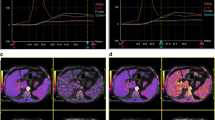Abstract
Positron emission tomography (PET) by means of a dynamic state method and H2 15O was performed to quantify splenic blood flow in 20 patients who had no hepatic functional disorders. Non-linear regression analysis was applied to determine splenic blood flow. In calculating arterial input function for the spleen, our originalexponential method was used to facilitate computerization. Mean splenic blood flow per 100 g of spleen (SBF) was 168.0 ml/min/100 g with a standard error (SE) of 12.4 ml/min. The mean spleen-blood partition coefficient for water(ρ) was 0.767 with a SE of 0.020. Significant correlations were noted between the values for SBF obtained by theexponential method andlinear method in which individual increasing values for arterial15O concentration were used rectilinearly (r=0.96, p< 0.005) and also between the values for ρ obtained by the two methods (r=0.95, p< 0.005). In order to validate the application of a one compartment model to an organ with a large blood volume such as the spleen, a further experiment was performed with a water flow model simulating splenic circulation.
We succeeded in quantifying regional splenic blood flow by PET. It was thought that the quantification of splenic blood flow by our method would be beneficial in the study of splenic circulation, which is expected to be altered under conditions of portal hypertension, liver dysfunction and shock, etc.
Similar content being viewed by others
References
Huchzermeyer H, Schmitz-Feuerhake I, Reblin T: Determination of splenic blood flow by inhalation of radioactive rare gases.Europ J Clin Invest 7: 345–349, 1977
Peters AM, Klonizakis I, Lavender JP: Use of111Indium-labelled platelets to measure spleen function.Br J Haematology 46: 587–593, 1980
Manoharan A, Gill RW, Griffiths KA: Splenic blood flow measurements by Doppler ultrasound.Cardiovascular Res 21: 779–782, 1987
Greenblatt JG, Koch-Weser J: Clinical pharmacokinetics (First of two parts).The New Eng J Med 293: 702–705, 1975
Murata K, Kohno K: Estimation problem due to multiple solutions in pharmacokinetic curve fitting to two compartment model and its avoidance.Biopharmaceutics & Drug Disposition 10: 15–24, 1983
Neider JA, Mead R: A simplex method for function minimization.Comp J 7: 308–313, 1965
Iida H, Higano S, Tomura N, et al: Evaluation of regional differences of tracer appearance time in cerebral tissues using [15O]water and dynamic positron emission tomography.J Cereb Blood Flow Metabol 8: 285–288, 1988
Heymsfield SB, Fulenwider T, Nordlinger B, et al: Accurate measurement of liver, kidney, and spleen volume and mass by computerized tomography.Ann Intern Med 90: 185–187, 1979
Huang SC, Carson RE, Hoffman EJ: Quantitative measurement of local cerebral blood flow in humans by positron computed tomography.J Cereb Blood Flow Metabol 3: 141–153, 1983
Herscovitch P, Markham J, Raichle ME: Brain blood flow measured with intravenous H2 15O. 1. Theory and error analysis.J Nucl Med 24: 782–789, 1983
Ketty SS: The theory and applications of the exchange of inert gas at the lungs and tissues.Pharmacol Rev 3: 1–41, 1951
Brunner MJ, Shoukas AA, Macanespie CL: The effect of the carotid sinus baroreceptor reflex on blood flow and volume redistribution in the total systemic vascular bed of the dog.Circ Res 48: 274–285, 1981
Price HL, Deutsch S, Marshall BE, et al: Hemodynamic and metabolic effects of hemorrhage in man, with particular reference to the splanchnic circulation.Circ Res 18: 469–474, 1966
Risöe C, Hall C, Smiseth OA: Blood volume changes in liver and spleen during cardiogenic shock in dogs.Am Physiol Soc H1763–H1768, 1991
Williams R, Condon RE, Williams HS, et al: Splenic blood flow in cirrhosis and portal hypertension.Clin Sci 34: 441–452, 1968
Gitlin N, Grahame GR, Kreel L, et al: Splenic blood flow and resistance in patients with cirrhosis before and after portacaval anastomoses.Gastroenterology 59: 208–213, 1970
Author information
Authors and Affiliations
Rights and permissions
About this article
Cite this article
Oguro, A., Taniguchi, H., Koyama, H. et al. Quantification of human splenic blood flow (Quantitative measurement of splenic blood flow with H2 15O and a dynamic state method: 1). Ann Nucl Med 7, 245–250 (1993). https://doi.org/10.1007/BF03164705
Received:
Accepted:
Issue Date:
DOI: https://doi.org/10.1007/BF03164705




